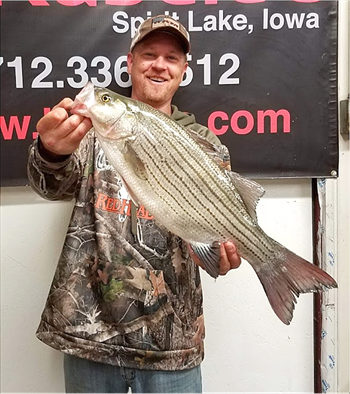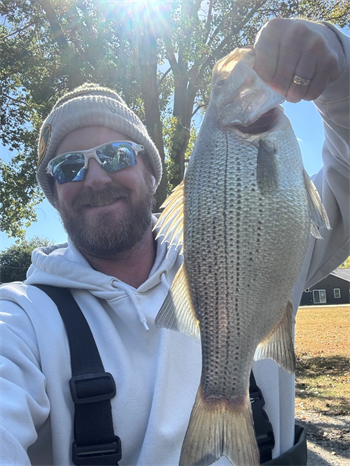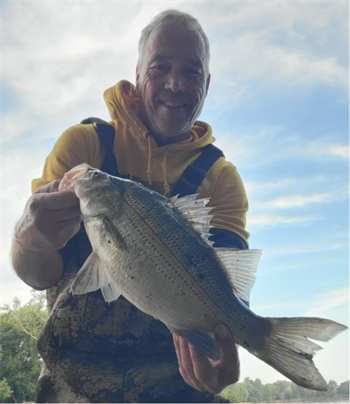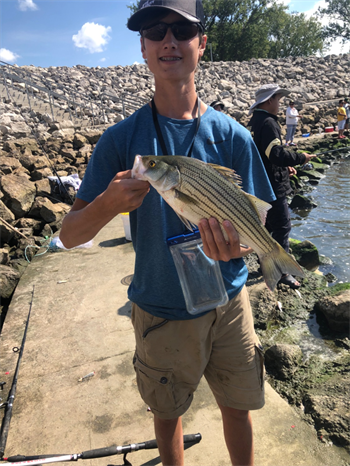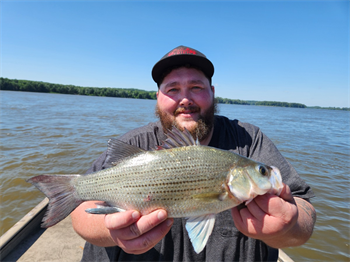Fish Iowa - Fish Species - White Bass
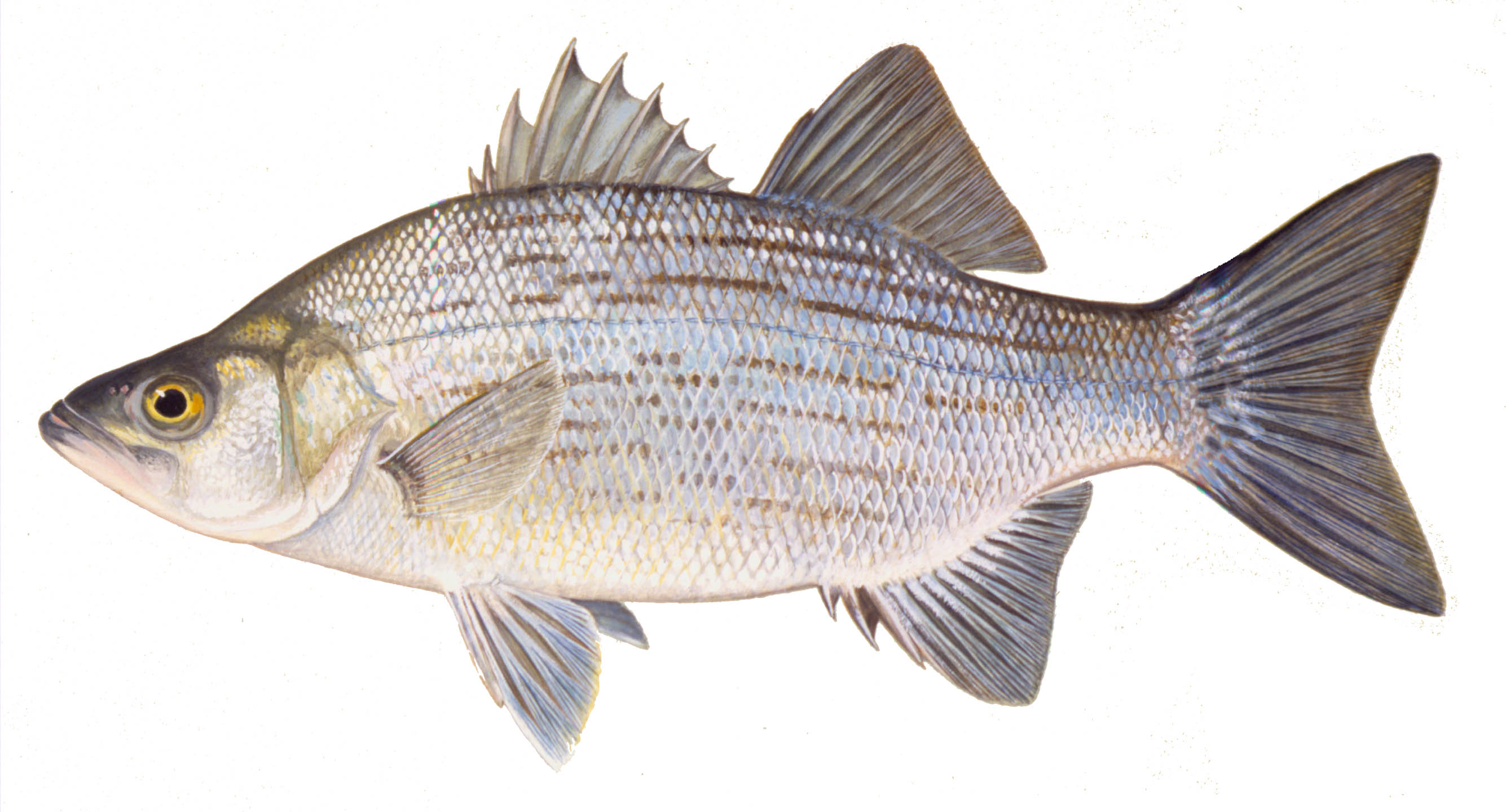
Characteristics
A slab-sided, blue-gray to silvery, spiny-rayed fish with slate gray dorsal, caudal and anal fins, white belly and pectoral fins. It has 5 to 7 longitudinal dark colored body stripes. Stripes on the body are usually interrupted, but not as sharply broken or offset above the anal fin as other fish in this family. The dorsal fin is separated into two complete lobes; the first has 9 spines and the second has a single spine with 13 to 15 soft rays. The anal fin has 3 spines graduating in length followed by 11 to 13 soft rays. The mouth is slightly oblique with the lower jaw projecting slightly beyond the upper jaw.
Foods
- No results found
Expert Tip
Use white and/or yellow jigs (1/8 ounce) in tandem where you see the schools of White Bass chasing minnows to the surface.
Details
Typical White Bass habitat is the deep, quiet pools of medium to large rivers and the mid-water environment of lakes and reservoirs. They are most often found in places with sand and gravel bottoms in clear to slightly turbid water.
Spawning is a spring ritual that occurs in Iowa from April through mid-June at water temperatures from 58 to 70 degrees. Sexually mature fish form schools, often unisexual groups, that move onto shoals or estuaries before spawning. Actual spawning starts when several males surround a female and the group swims around scattering eggs and milt near the surface. The eggs are small, averaging about .031 inch in diameter. The number of eggs produced varies from about 241,000 to 933,00 per mature adult female, with the number proportional to body size. Once released, the eggs are fertilized and gradually sink to the bottom where they stick to rocks and bottom debris and hatch in several days. No parental care is given eggs or newly hatched fry.
White Bass grow fast, averaging 4- to 6-inches in the first year, 9- to 10-inches in the second year, and 12- to 14-inches by the end of the third year. Most males mature at age 2, while females mature at age 3. White Bass seldom live beyond 4 years and few are larger than 2- or 3-pounds.
White Bass usually forage in early morning and late afternoon, while adults are sometimes seen eating in the dark. This species is highly mobile, moving about in large schools, hungrily feeding on other schooling fish, such as Gizzard Shad. In Iowa, Gizzard Shad are needed to establish White Bass in reservoirs and large rivers. White Bass use other forage fish, particularly minnows and shiners, in the natural lakes for food.
Recent stream sampling information is available from Iowa DNR's biological monitoring and assessment program.
Distribution Map

Common to abundant throughout the Mississippi River and in the lower reaches of its main tributary streams. Sizable populations in the flood control reservoirs that impound the interior rivers, Red Rock, Rathbun and Coralville. Its range also includes the Missouri River and tributaries. Common in many natural lakes including: Storm, North Twin, Blackhawk, East and West Okoboji, Spirit, Minnewhasta, Upper and Lower Gar and Clear lakes.
See our most recent distribution data for this species on the Iowa DNR's Bionet application.
Fish Surveys
Tip: Click Species Length by Site, then use the dropdown to filter by fish species of interest.Where this Fish Is Found
Big Creek Lake
Big Lake (Lansing)
Big Sioux River
Big Timber Complex
Burlington Street Dam
Cedar River (Cedar Rapids to Moscow)
Cedar River (La Porte City to Cedar Rapids)
Center Lake
Clear Lake
Coralville Reservoir
Des Moines River (Saylorville to Red Rock)
Des Moines River (Stratford to Saylorville Lake)
DeSoto Bend at DeSoto National Wildlife Refuge
East Okoboji Lake
Gateway Park North
Gimmel Lake
Iowa River (Columbus Junction to Mississippi R)
Iowa River (Coralville Lake to River Junction)
Iowa River (Marshalltown to Coralville Lake)
Jay Carlson Pit (west)
Lake Cornelia
Lake Macbride
Lake Petocka
Little Sioux River (Correctionville to Missouri R)
Little Sioux River (state line to Linn Grove)
Little Spirit Lake
Lost Island Lake
Manhattan Robbins Lake Park
Maquoketa River (below Monticello)
Martelle Lake
Minnewashta Lake
Missouri River (Council Bluffs to state line)
Missouri River (Little Sioux to Council Bluffs)
Missouri River (Sioux City to Little Sioux)
Mohawk Park Lake
North Raccoon River (Perry to Van Meter)
Pleasant Creek Lake
Pool 09, Mississippi River
Pool 11, Mississippi River
Pool 12, Mississippi River
Pool 13, Mississippi River
Pool 14, Mississippi River
Pool 15, Mississippi River
Pool 16, Mississippi River
Pool 17, Mississippi River
Pool 18, Mississippi River
Pool 19, Mississippi River
Prairie Park Fishery
Purple Martin Lakes
Rathbun Reservoir
Red Rock Reservoir
Roberts Creek Lake
Sand Lake
Saylorville Reservoir
Scharnberg Pond
Seminole Valley Park Lakes
Silver Lake (Dickinson)
Skunk River (Coppock to Mississippi River)
Spirit Lake
Storm Lake (incl Little Storm Lake)
West Okoboji Lake
Yellow Smoke Park Lake
